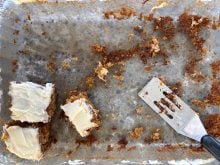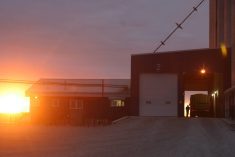Producers put the rocks they have collected over the years to good use while remaking a front yard patio
Our neighbour Stewart was surprised when he spied a large rock on top of the feeder house of the combine when he called one day at harvest time. He couldn’t believe anyone would stop, get off the combine and pick a rock, much less travel around the field with it until end of day.
I have collected rocks of many shapes, sizes, and colours in the field while seeding or harvesting. They end up in gardens in the farm yard, or the rock pile behind the Quonset.
Read Also

VIDEO: Bittersweet harvest for this family farmhand
Bruce Burnett helps his brother harvest wheat and canola for the last time on the family farm in Manitoba where they both grew up.
As kids, my brothers and sisters and I would spend part of the summer holiday picking rocks in the summerfallow, piling them on the wagon behind the tractor, and throwing them off at the edge of the field. Perhaps that is why I can’t resist picking up a good rock now and then when I am combining.
My husband painted “Stewart the Rock” on the large piece of granite and we presented it to Stewart as an homage to Harvest 2022. The rock will likely become a doorstop in a farm building or a pedestal for a plant.
A few years ago, we visited friends in Montana who have a house on an alpine lake. Our friend, Lucy, remarked that she had always wanted a winding path up to her door, so we spent our holiday with them constructing a path out of the beautiful field rock that was readily available in their yard. She loves the character of the path, the story she tells about its formation, and the “Thomas Kincaid” look it gives to her house.
My penchant for picking rocks has resulted in a motley assortment of rocks stored at the edge of the gravel path to our farmhouse. This past summer, my husband and I designed a small patio in front of the farmhouse to replace the gravel path and embed my collection of rocks.
We planned to pour the path on a weekend in September. We were using small bags of premix, so time was of the essence. It hadn’t rained all summer, the forecast was for two millimetres (we knew that wouldn’t happen), so we invited a few family members to join our crew.
We constructed the forms and laid the rebar on the Saturday and as luck would have it on Sunday, we woke to overcast skies and mist. We thought we could manage the moisture.
Long story short, we poured half the pad, and then the rain came. Three millimetres fell and while that may not sound like much to a farmer, it is a significant amount if you are working with cement.
Placing the rocks turned out to be even more complicated than pouring the cement as everyone had to weigh in on the best way to do it.
Note for next time: always stick to the plan. The rocks were placed in the concrete, we covered the pad with plastic and planned to continue when everyone was available again.
Three weeks later we poured the second half of the pad and this time we went with the original idea of placing the rocks.
The project was collaborative and we were able to complete it this time. It is still a work in progress, as we look for a magical sealant to disguise all our mistakes.
Like every other project on the farm, this one has a back story, family and friends are involved, and it has a name. This one is called “the Breakup of the Pangea” because it reminds us of the description of the break-up of the supercontinent that formed during the Paleozoic era.

















